Chronicles of Complementary, Alternative & Integrative Medicine
Research Article
Turmeric (Curcuma longa L) Oil as Antioxidant Agent in Starch-Based Edible Coating Film for Fresh-Cut Fruits
Sharif ZIM1, Subuki I1, Zaki NAM1, Mustapha FA1, Yusof NM1, Jai J1*
Faculty of Chemical Engineering, Universiti Teknologi MARA, 40450 Shah Alam, Selangor, Malaysia
*Corresponding author: Jai J, Faculty of Chemical Engineering, Universiti Teknologi MARA, 40450 Shah Alam, Selangor Malaysia, Tel: +603 5543653, Fax: +60355436300, E-mail: junejai@uitm.edu.my
Citation: Sharif ZIM, Subuki I, Zaki NAM, Mustapha FA, Yusof NM, Jai J (2019) Turmeric (Curcuma longa L.) Oil as Antioxidant Agent in Starch-Based Edible Coating Film for Fresh-Cut Fruits. Chronic Complement Altern Integra Med: CCAIM-100005
Received date: 07 May, 2019; Accepted date: 21 May, 2019; Published date: 13 June, 2019
Abstract
Edible coating with the presence of antioxidation agent is one of the methods for inhibiting the enzymatic browning activity involved in fresh-cut fruits deterioration. This research evaluates the potential of extracted turmeric oil (TO) as an antioxidation agent. The ability of starch/carboxymethyl cellulose (CMC) edible coating incorporated with TO in delaying the oxidation process on the surface of fresh-cut ‘Fuji’ apples was analysed. TO was extracted from turmeric rhizomes through hydro distillation method. The extracted TO oxidation analysis were done through GC-MS and DPPH assay. The results show that ketonic sesquiterpenes and aliphatic monoterpenes compounds were presence in the TO and from DPPH analysis, it shows that at 30 μL/mL concentration of TO had the highest percentage effect of scavenging which is 89%. Antioxidation efficiency was evaluated through oxidase enzyme activities of the fresh-cut fruits coated with and without TO. Results show that the presence of TO has suppressed the oxidase activity of the fresh-cut fruits by 9%. Therefore, it can be concluded that the edible coating film incorporated with TO as antioxidation agent can be used as an alternative method in preserving the fresh-cut ‘Fuji’ apples.
Keywords: Antioxidation; Enzymatic browning; Edible coating; Fresh-cut fruits; Turmeric oil; Thickness
Abbreviations
TO : Turmeric oil;
CMC : Carboxymethyl cellulose;
PPO : Polyphenol oxidase
Introduction
Consumers now a days prefer to go for ready-to-eat foods, including fresh-cut fruits, in their eating plan rather than preparing the foods themselves due to limited time [1]. As these fruits are high in antioxidants, consumers are beginning to realise that consuming them can help in countering numerous types of illnesses [2]. The introduction of fresh-cut fruits into commerce and making them available on the market is restricted, as they have short shelf life and are easily spoiled. These are the reasons as to why the economy of the fresh-cut fruits are affected [3]. The cells and tissue of fruits will encounter structural damage during cutting and peeling processes. This results in dehydration, microbial spoilage and generation of unpleasant tastes and odours in the fruits, thus diminishing their quality [4,5]. In addition, the escalating production of ethylene will expedite the ripening process [6]. When the surface of the fresh-cut fruits turns to brown, it indicates that the oxidation process may have occurred. The oxygen from the surrounding reacts with the oxidase enzymes on the surface of the fresh-cut fruits [7].
There are different methods of preservation used to increase the shelf life of fresh-cut fruits, such as the conventional or modern methods that include pickling, drying, high pressure processing, and edible coating, among others. Certain techniques work with additives for a more effective preservation process [8]. Nevertheless, the organoleptic properties of these fresh-cut fruits may be affected by these preservation techniques. For instance, the original taste of fresh-cut fruits will change upon pickling process and the drying method will cause a loss of moisture content, thus changing the appearance and taste of the fruits. The edible coating is the most favourable method in retaining the conditions of fresh-cut fruits. The thin films are edible coatings that help to improve the quality of the fruits and secure them as edible items [9].
The edible coating becomes the boundary layer for water vapour, gases and flavour compounds in enhancing the structural integrity of the fresh-cut fruits. Besides that, the usage of packaging was lessening as edible coating method is used. This is due to its edible characteristics, where the shelf life of the fruits can be extended while contributing to cost-effective packaging materials [10,11]. Natural edible coatings provide many advantages in shielding the food, compared to using synthetic edible coatings. Apart from that, natural products are seen to be safer for consumption, as they are non-toxic and cost-effective [12].
The edible coatings of fresh-cut fruits can be formed from a variety of base coatings such as polysaccharide (chitosan, starch, alginate, et cetera), protein (whey, zein corn, soy protein, et cetera.) and lipids (bees wax, corn oil, fatty acids, et cetera) [13-17]. Rather than using a single type of basic constitutent, a mixture of the three basic constituent groups with other additives can also form edible coatings, where it is known as the composite edible coating [18,19]. In this research, a mixture of cassava starch and carboxymethyl cellulose is used, where the cassava starch acted as the base of the edible coating and the carboxymethyl cellulose was the filler used to stabilising the cassava starch-based edible coating film.
In this study, the edible coatings were used for fresh-cut ‘Fuji’ apples because these apples tend to face oxidation activity problem after they are cut. ‘Fuji’ apples have high sugar content and are especially prone to having water core. Therefore, it can easily deteriorate during post-harvest and making it unsuitable for long storage [20]. Some of the perks of the edible coating are that it can extend the shelf life of the fresh-cut ‘Fuji’ apples while maintaining its freshness and appeal, as well as taste [21]. Other than that, edible coating can even help in preserving the apples in low-temperature condition post-harvest [10]. This is because the oxidation activity is put off until later time by an antioxidant agent provided by the edible coating. The turmeric oil was used as the antioxidation agent in this research.
Turmeric is a long-lasting, herbaceous and sweet-smelling plant originating from the ginger family (Zingiberaceae) called the Curcuma longa L., also known as just curcuma (turmeric) [22]. There are secondary metabolite compounds in every part of the turmeric; nevertheless, the roots of the turmeric have the highest content of the said compound. These compounds are what make the turmeric an antioxidation agent. The oxidation activity is postponed or reduced due to the presence of synergy between the secondary metabolite compounds (active compounds) in the turmeric, consisting of flavonoid curcumin and various volatile oils (e.g., turmerone, curlone, zingiberene, et cetera) [22]. Turmeric was chosen in this study due to its ability as antioxidant agent better compared to vitamins C and E due to the presence of high active compounds such as curcumin [23]. Furthermore, there was research reported [23] shows that the ability of curcumin in enhancing the cellular resistance from oxidative damage is better than vitamin C and E.
The determination of antioxidation activity relies on the functional groups, compositions and structure of the essential oils. Complex compound mixtures such as monoterpene, sesquiterpenes and oxygenated derivate like alcohol, aldehydes, esters, ether, ketones, phenols, and oxides are found in essential oils [24]. Ultimately, the oxidation activity that transpires on the surface of fresh-cut fruits is inhibited by the use of essential oils as an alternative instead of using chemicals for the said purpose. Other than that, essential oils are also capable of lowering the polyphenol oxidase and peroxidase activities in fruits [25].
In this study, cassava starch, carboxymethyl cellulose (CMC) and turmeric oil (TO) were used to produce the edible coating emulsion, where cassava starch acted as the based material, CMC as the filler and TO as the antioxidant agent. This work aims to determine the effect of TO in edible coating film as antioxidation agent.
Materials and Methodology
Materials
Cassava starch (Cap Kapal ABC, Malaysia), CMC (Novelecell, Malaysia) and TO were used in the formulation of coating film. Citric acid (Merck, United State) was used as the cross-linking agent. Glycerol (Merck, United State) was used as plasticizer and TO was used as antioxidation agents. Fresh ‘Fuji’ apples were used as the samples for edible coating analysis. Fresh ‘Fuji’ apples of regular shape, same size without any defect and half ripe with 50% of the surface was red in colour were selected from local market in Shah Alam, Malaysia.
Extraction of Turmeric Oil (TO)
TO was extracted from turmeric rhizomes through hydro distillation method by using Clevenger apparatus. The hydro distillation extraction process was done according to [26]. The turmeric rhizomes were weighed for 400g, cleaned and washed with clean water. The turmeric rhizomes (Figure 1) were dried by using paper towel. They were sliced and placed in 5000 mL round flask which contains 1000 mL of distilled water. The temperature of heating mantel was set at 200°C for constant boiling while time was set for 3 hours after the distilled water in round flask started to boil. Then the extracted TO was collected and measured for its volume and weight. Lastly, the sample was kept in amber bottle and placed in the chiller at temperature of 6°C for stability of the extracted TO.
Coating Solution Preparation
Modified starch solution was prepared by diluting 6 g of cassava starch with 100 mL of distilled water and stirred for 40 min at 80°C with constant stirring at 350 rpm to reach full gelatinization stage. Then, 0.5% (w/v) 0.5 M citric acid of distilled water was added in the mixture as the cross-linking agent and stirred for 5 min. The 2% (v/v) glycerol of distilled water was added in the mixture as plasticizer and continually stirred for another 5 min. On the other hand, CMC solution was prepared by solubilizing 2% (w/v) CMC in 100 mL of distilled water for 30 min at 75°C with constant stirring. The modified starch solution and CMC solution were then mixed and stirred at 75°C for 30 min with constant stirring to achieve homogeneous state. Finally, 17.5 μL/mL of TO were added into the 100 mL of edible coating emulsion.
Fresh-Cut ‘Fuji’ Apples Preparations
The ‘Fuji’ apples were washed and soaked in distilled water until all the impurities on the surface of the apples were washed away. Apples were rinsed and pat dried by using kitchen towel. Then, it was cut into wedges shape with approximate weight of 25 g each by using sharp stainless-steel apple cutter. Apple cutter and the cutting board were rinsed in distilled water, sterilize using ultraviolet light and sanitized using 90% ethanol before being used.
Measurement of Extracted to Antioxidant Capacity
The extracted TO antioxidant capacity were analysed through Gas Chromatography – Mass Spectrometry (GC-MS) (Varan (Model: 450-GC), USA) and DPPH assay. GC-MS was done according to [27]. The temperature of GC-MS injector was set at 100°C by using the spitless mode and 1.0 μL of turmeric oil was injected into it. The percentage compositions of turmeric oil were analyzed using standard reference compounds. While for DPPH assay, different concentrations of turmeric oil were prepared in methanol which in range 5 to 30 μL/mL. The concentration of 60 μM methanolic DPPH solution was prepared and stored in amber bottle. The 1 mL of 60 μM methanolic DPPH solution was added to 1 mL of different concentrations of turmeric oil in methanol and the bottle was shake. The method was done in open air condition with room temperature (24°C). The absorbance reading was taken at 517 nm by using UV-Vis spectroscopy (Perkin Elmer, United Kingdom).
Determination of Oxidase Enzyme Activities
The oxidase enzyme activities were determined according to procedures [28,29] with some modifications. The coated and uncoated fresh-cut fruits were kept in chill room (4°C) with 80% relative humidity of storage before analyses at day 1, day 3 and day 5. The extraction of oxidase enzyme from fresh-cut apples was acquired by homogenizing the coated and uncoated samples with 50 mL of 0.1 M sodium phosphate buffer with pH 6.8 and temperature of 4°C. The buffer solution contained 10 g/L polyvinylpyrrolidone and 5.0 g/L Triton X-100 and known as modified buffer solution. The fresh-cut ‘Fuji’ apples were blended with modified buffer solution by using Waring 7011HS laboratory blender. The fresh-cut ‘Fuji’ apple juice or known as crude was collected. The reaction mixture of catechol solution and enzyme in crude was formulated in 0.05 M sodium phosphate buffer at pH 6.8. The absorbent reading was measured with UV-Vis spectroscopy (Perkin Elmer, United Kingdom) at 420 nm in room temperature. The blank used was the substrate solution. The enzyme activity of coated fresh-cut ‘Fuji’ apples with different concentrations of TO (0 μL/mL and 17.5 μL/mL) and uncoated fresh-cut ‘Fuji’ apples (control) were compared. Each of the samples was assayed in triplicates.
Results
Turmeric Oil Antioxidant Capacity
Table 1 shows the analysis of composition compounds in extracted turmeric oil through GC-MS. There were fifty compounds were analysed presence in the extracted TO including volatile and non-volatile compounds but only the highest compositions were tabulated in Table 1. It can be seen that turmerone (35.46 ± 0.07%) had the highest composition followed by ar-turmerone (13.82 ± 0.02%), cumene (20.61 ± 1.38%), curlone (3.11 ± 0.04%), curcumene (0.43 ± 0.02%) and cymene (0.90%). These volatile compounds were known as ketonic sesquiterpenes and aliphatic monoterpenes compound. This is in agreement with the results reported [30,22] stated that, the major compounds found in turmeric oil extracted from rhizomes were Ar-turmerone.
Figure 2 shows the percentage effect of scavenging (%) against time. It can be observed that, the 30 μL/mL concentration of turmeric oil has higher percentage effect of scavenging. The effect of scavenging was increased during 0 to 40 min by 4% for 5 μL/mL, 9% for10 μL/mL, 12% for 20 μL/mL and 16% for 30 μL/mL. This indicates that, it tends to have high ability in transferring the hydrogen atom to the radical. Similar findings have been observed from [31] which reported the higher concentration of oregano essential oil used, have higher percentage effect of scavenging.
Oxidase Enzyme Activities of Coated Fresh-Cut ‘Fuji’ Apples
Figure 3 shows the oxidase enzyme activities of the apples within five days of storage. An increase of storage time has increased the oxidase activity of the fresh-cut fruit for all condition under study. Uncoated fresh-cut fruits have higher oxidase activity than the coated samples. Figure 4 shows the oxidation percentage of the fresh-cut fruits for all condition under study and day 1 was taken as reference. Sharp linear increase in oxidase activity of uncoated sample with storage time can be seen. Oxidation of the uncoated fresh-cut fruits has increased to 42% and 62% at day 3 and day 5, respectively. At day 1, oxidase activity of coated fresh-cut fruits with (17.5 μL/mL) and without (0 μL/mL) the incorporation of TO were almost similar. However, on the day 3 and day 5 of storage, oxidase activity of the fresh-cut fruits without TO was higher than the sample coated with 17.5 μL/mL of TO. These findings were supported by previous works [32,18,33] which stated that the edible coating had potential in maintaining the fruits organoleptic properties. Furthermore, the increase of oxidase activity of the fresh-cut fruits with 0 μL/mL of TO was not consistent. The oxidation has increased to 34% at day 3 and suddenly reduced to 23% at day 5. The reduction occurred may due to the less production of phenolic compound in the fresh-cut ‘Fuji’ apples. Nevertheless, the fresh-cut fruits with 17.5 μL/mL of TO have shown only slight increase of oxidase activity, oxidation increases to 3% and 9% at day 3 and day 5, respectively. Figure 5 shows the pictures of uncoated and coated fresh-cut ‘Fuji’ apples within the 5 days of storage time. Findings of the oxidase activities were confirmed by the colour changes of the fresh-cut ‘Fuji’ apples.
Discussion
This similar trend was reported by [34] on the oxidase enzyme activities of fresh-cut mangoes. The excessive oxidase enzyme activities led to the browning process could also attributed to deterioration of fresh-cut ‘Fuji’ apples [5,16, 17]. The presence of TO in edible coating improved the fresh-cut ‘Fuji’ apples condition and delayed the enzymatic browning process on its surface. Furthermore, they also reported that control (uncoated) sample had higher oxidase enzyme activities because the cutting process led to the discharge of phenolic compounds from vacuoles and the oxidase enzymes from the chloroplast. The possible oxidase enzymes that could be found in the crude were polyphenol oxidase, catecholase, laccase and phenolase. It can be concluded that the coating solution incorporated with TO successfully delayed or inhibited the oxidation process of fresh-cut ‘Fuji’ apples compared to uncoated apples. Figure 6 shows the mechanism of TO in delaying the oxidation process occurred on the fresh-cut ‘Fuji’ apples. TO prevent the formation of browning by reacting with oxygen from surrounding. It was seen in the Figure 6 that curcumin reacted with oxygen present in environment and produced dehydro-curcumin and water. This process interrupted the formation of melanin as the oxygen was absence from the process.
Conclusion
Findings obtained from the study presented that the addition of TO in the starch/CMC edible coating film has reduce the oxidation percentage of the fresh-cut ‘Fuji’ apples. Furthermore, the TO has able to control with slight increase of the oxidase enzyme activity within the storage time. Hence, the potential of TO as antioxidant agent in edible coating has been proven. It is suggested that further analysis on the sensory test could be carry out to study the effect of TO towards the taste of fresh-cut ‘Fuji’ apples. The data obtained from this research could provide knowledge on the potential of natural sources to replace synthetic coating and be beneficial towards the development of safer alternatives to the manufacturer in Malaysia food industries.
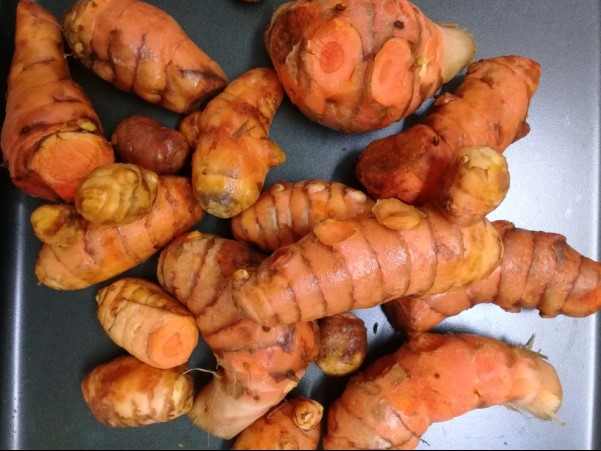
Figure 1: Turmeric rhizomes.
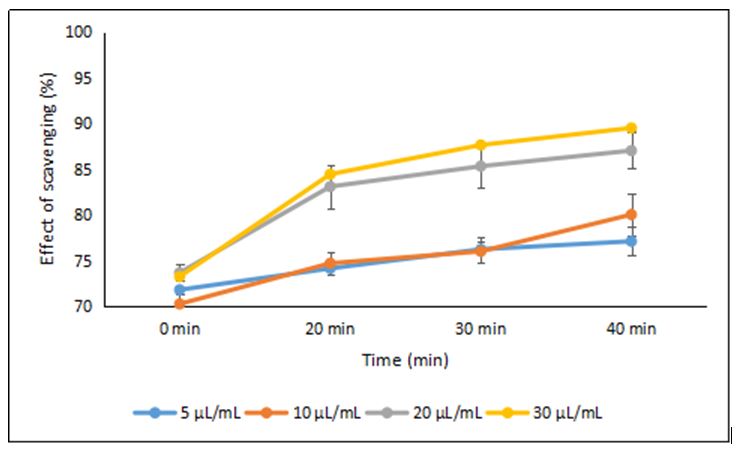
Figure 2: Antioxidation activity of different concentration of turmeric oil.
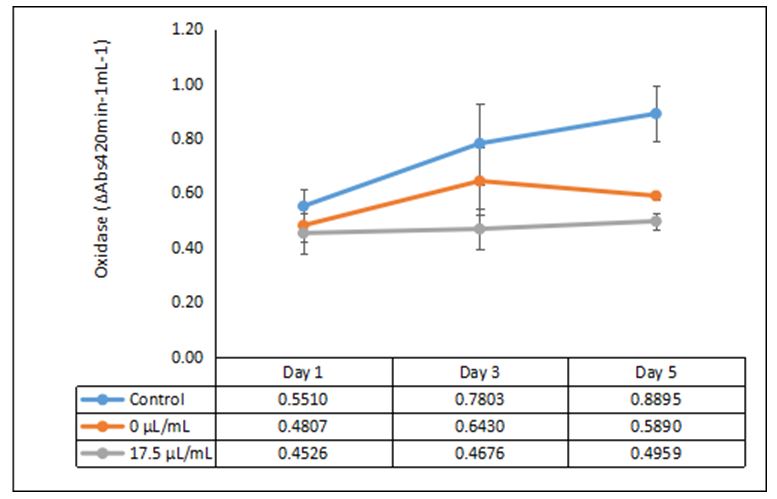
Figure 3: Oxidase Activity of Fresh-Cut ‘Fuji’ Apples coated with 0 and 17.5 μL/mL TO for 5 Days.
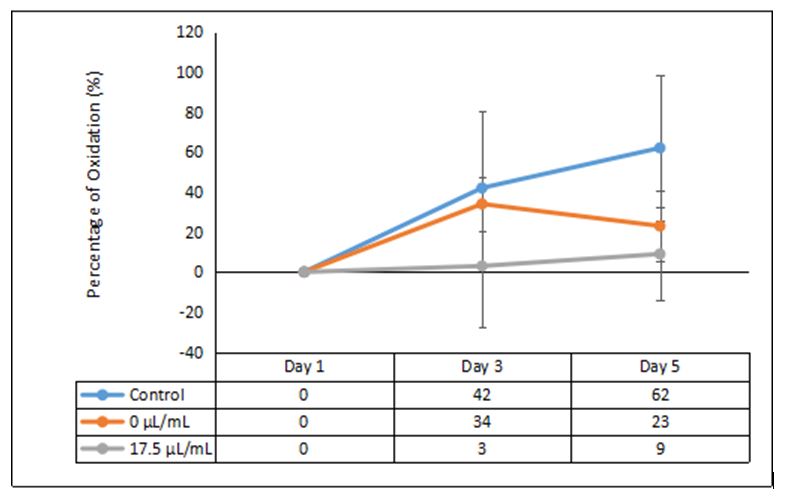
Figure 4: Oxidation Percentage of Fresh-cut ‘Fuji’ apples with and without TO.

Figure 5: Fresh-cut ‘Fuji’ apples uncoated and coated with 0 and 17.5 μL/mL of TO.
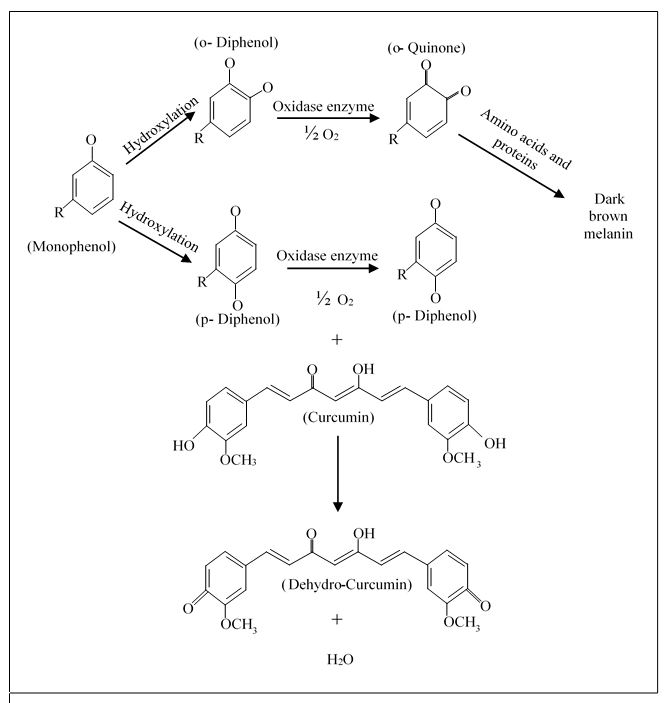
Figure 6: Antioxidation mechanism of turmeric oil.
|
Compound Name |
Retention Indices |
Peak area (%) |
|
|
|
|
|
Curcumene |
28.71 |
0.43 ± 0.02 |
|
Curlone |
34.70 |
3.11 ± 0.04 |
|
Ar-Turmerone |
35.82 |
13.82 ± 0.02 |
|
Turmerone |
36.00 |
35.46 ± 0.70 |
|
Cumene |
37.15 |
20.61 ± 1.38 |
|
Cymene |
39.07 |
0.90 ± 0.06 |
Table 1: Percentage composition of compounds found in extracted turmeric oil.
Citation: Sharif ZIM, Subuki I, Zaki NAM, Mustapha FA, Yusof NM, Jai J (2019) Turmeric (Curcuma longa L.) Oil as Antioxidant Agent in Starch-Based Edible Coating Film for Fresh-Cut Fruits. Chronic Complement Altern Integra Med: CCAIM-100005